skip to main |
skip to sidebar
The Spanish/English dictionary no longer tags along in my purse— instant access, tangible answers to unraveling the unknowns of Spanish. Well-thumbed pages and separated binding witness its use. Cheat sheets of verb conjugations struggle to find their place in unglued pages.
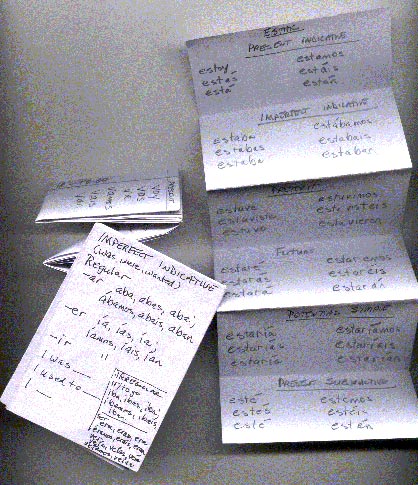 This summer of Spain is over. But annotations for my dictionary of Spain still pend, harder now with a keyboard bare of accented vowels.¿Quién sabe que aventura viene próximo?
This summer of Spain is over. But annotations for my dictionary of Spain still pend, harder now with a keyboard bare of accented vowels.¿Quién sabe que aventura viene próximo?
I enter the gates of the gardens of the Alcázar, resigned to the bothers of open-air concerts--mosquitoes, heat, traffic noise. My list is long and personal.
Inside, I feel a manton of peace settle around me. Tranquilo, as C says at the house. The gardens work their magic.Música Prima takes the stage, and the city melts away. There is only this--clear sky, cooling winds swaying the sky-sweeping palm trees, and music from the Middle Ages.

It is the International Year of Reconciliation. Period instruments weave a fabric of music--Christian, Sephardic Jew and Islamic--distinct but nuanced by years of intwined existence. Strings and percussion carry the notes with familiar shapes and sounds; wind intrigues with mechanical rarities, organetto, a portable pipe organ, and zanfoña, a hurdy-gurdy.
Literal meaning takes shape as familiar words emerge here and there in explanation and lyric. It is the music itself, though, that transcends spoken word, a way of knowing through the centuries.
The church bell, when it finally tolls, loses it metallic harshness and drifts into the soft night air, an anonymous fourth to the group´s trio.
For an hour or six this morning, Sevilla´s empty blue sky greyed, hinting at the possiblity of rain. Was that a drop just now? Alas, only the condensate from the air conditioners overhead. Wewake from siesta to perennial azure.
Between the Rio Guadalquivir and the Plaza de España lies El Parque de María Luisa, a multi-faceted green jewel in a much-paved city. Among the eucalyptus, palm and jacaranda trees I am Lilliputian, dwarfed by their height and girth. The colossal flora are emphemera of a different era, Sevilla´s breath, held in times of crisis and carefully exhaled in times of rebirth. Originally, the gardens of the palace of San Telmo, patron saint of mariners, the Duchess of Bourbon gave them to Sevilla. They sat neglected until the city incorporated them into the grand setting for the 1929 Ibero-American Exposition--a showcase for the pavilions of the former Spanish and Portuguese colonies.Fortunes rise and fall. The 1929 Ibero-American Exposition failed to generate the hoped-for economic boost for Spain and Portugal, opening as the stock market crashed. Revolutions and civil wars sent the park, once Sevilla´s only public park, into neglect again. It rises once more, a splendid setting for the museums that now occupy the former pavilions of the 1929 expostion.
Originally, the gardens of the palace of San Telmo, patron saint of mariners, the Duchess of Bourbon gave them to Sevilla. They sat neglected until the city incorporated them into the grand setting for the 1929 Ibero-American Exposition--a showcase for the pavilions of the former Spanish and Portuguese colonies.Fortunes rise and fall. The 1929 Ibero-American Exposition failed to generate the hoped-for economic boost for Spain and Portugal, opening as the stock market crashed. Revolutions and civil wars sent the park, once Sevilla´s only public park, into neglect again. It rises once more, a splendid setting for the museums that now occupy the former pavilions of the 1929 expostion.


 A small gem emerges from the green, glimpses of azure and terracotta teasing through the shrubs. The tiled pool sits quietly among the eucalyptus, their leaves floating serenely on the water´s surface.
A small gem emerges from the green, glimpses of azure and terracotta teasing through the shrubs. The tiled pool sits quietly among the eucalyptus, their leaves floating serenely on the water´s surface.

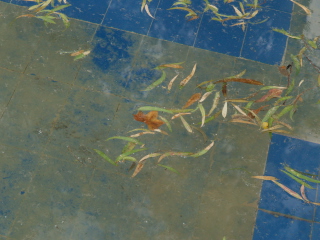
On a raised backdrop, a ceramic relief shows two caravels, their sails filled with wind. This small, outdoor room honors Los Hermanos Álvarez Quintero, Serafín and Joaquín, beloved writers of plays, dramas, and the quintessential zarzuela. Their works, extremely popular in the early twentieth century, a rebirth of Spanish theatre.

A small banner floats across the top of the relief, "Un mismo aliento impulsa las dos velas...." A single breath pushes two ships....
A single breath pushes two ships....
In El Parque de María Luisa, I hear Spain, its breath soughing through the jacarandas, pushing this rebirth of its Andalusian heritage.
Shrieks. Staccatoed footsteps. PSSSSSSSSSSST! of aerosol spray. Another roach lies writhing on a sidewalk in España, chased from house and home by indignant women. Ningunas de los mujeres españolas aplasta las cucarachas con sus zapatos. (No Spanish women squash cockroaches with their shoes.) Shivers and goosebumps testify to their repulsion, the personal affront.
La Cucaracha, the corrido popularized in the Americas during the Mexican Revolution may have emerged in Spain much earlier. A compilation of folk music published in Sevilla in 1883 references earlier lyrics alluding to the Reconquista in 1492.
1492. The last year of the 69th Chinese sexegenary cycle, a yin water bug year. Waterbug, another name for cockroach. Spread throughout the world via ships.
I remain at odds with Madrid. It shows. I stall, trying to decide what to say and what not to say. It has been nearly one month. The muscles at the base of my neck contract.I can say the Juan Muñoz retrospective at the Museo Nacional de Art Reina Sofía was delightful, engaging. I could have spent hours there, wandering among the galleries, looking at the playfulness of the work, a rapt audience to his creative vision and energy. 
I can say that the Reina Sofía´s contribution to the 2009 PhotoEspaña, The Atlas Group (1989-2004) Un proyecto de Walid Raad, is a powerful archive of Lebanon´s civil war, documented through both the quotidian and the unimaginable.
Secrets in the Open Seas made concrete the power of saying less in its series of four prints in various shades of blue, color chips from a paint store in which the price was too high. At the bottom of each image, a Pantone number identifies the tint and a single strip of images, printed as if contact prints from a single roll of film, tells the story of the group photographs each frame contained. The images, taken from 29 photographic prints in varying shades of blue, were found in the rubble of Beirut´s downtown commercial district. Every person in the photographs, man and woman, identified by The Atlas Group. Every person dead, in the Mediterranean, during the years of the war.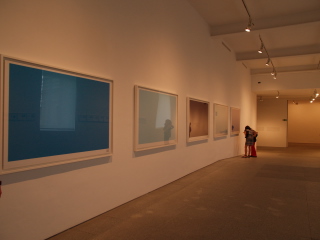 I can say the Museo Nacional del Prado is magnificent--Guernica, and Picasso's series of charcoal studies of the horrified mother cry out at the unimaginable. So much to see and absorb, the Joaquín Sorolla exhibit is a casualty.I can say that the Museo de Arte Thyssen-Bornemisza reveals the passion of collecting art, personalizing its depth and highlighting its idiosyncrasies. I can say the museo´s temporary exhibition, Matisse: 1917-1941, is intriguing, revealing the artist´s path in his middle years. Gallery 5, focusing on form, particularly his nudes and the study for the Dance Mural Composition, captures the tension of his work in the early 1930´s. I can say that My Things, an exhibition of work by Beijing artist Hong Hao at La Galería de Art Dolores de Sierra, part of PhotoEspaña, overwhelms me in a meticulous Where´s Waldo dimension. The minutae of his life broadens into a mosaic that resonates in Spain but offers me nothing new.
I can say the Museo Nacional del Prado is magnificent--Guernica, and Picasso's series of charcoal studies of the horrified mother cry out at the unimaginable. So much to see and absorb, the Joaquín Sorolla exhibit is a casualty.I can say that the Museo de Arte Thyssen-Bornemisza reveals the passion of collecting art, personalizing its depth and highlighting its idiosyncrasies. I can say the museo´s temporary exhibition, Matisse: 1917-1941, is intriguing, revealing the artist´s path in his middle years. Gallery 5, focusing on form, particularly his nudes and the study for the Dance Mural Composition, captures the tension of his work in the early 1930´s. I can say that My Things, an exhibition of work by Beijing artist Hong Hao at La Galería de Art Dolores de Sierra, part of PhotoEspaña, overwhelms me in a meticulous Where´s Waldo dimension. The minutae of his life broadens into a mosaic that resonates in Spain but offers me nothing new. I can say that Petra's International Bookshop is a stolen gem of one morning´s hour, a Charing Cross transplant down a small, tucked away Madrid street. An ex-pat's oasis of English language books, some beloved and some still in line on the same shelf since the 1970's. In a word, it is tiny, stacked full of used books, some still in the suitcases in which they were purchased. A pen-and-ink portrait of Petra, the bookshop's eponymous cat, hangs in memorium over the shelf entitled,"Chick Lit." It is about the books; it is about being able to hold them in hand.
I can say that Petra's International Bookshop is a stolen gem of one morning´s hour, a Charing Cross transplant down a small, tucked away Madrid street. An ex-pat's oasis of English language books, some beloved and some still in line on the same shelf since the 1970's. In a word, it is tiny, stacked full of used books, some still in the suitcases in which they were purchased. A pen-and-ink portrait of Petra, the bookshop's eponymous cat, hangs in memorium over the shelf entitled,"Chick Lit." It is about the books; it is about being able to hold them in hand. I can say that I am left wanting. I reach Madrid Sunday afternoon, too late to visit El Rastro, the famous Madrid flea market. S and I venture forth on a weekday, determined to ferret out some of the shops that parallel the streets that brim with blanket vendors on Sunday mornings. Treasures abound. I find wooden bobbins for making lace. S finds three fans, hand-painted and restorable, and a toy boxed compass. She wins.
I can say that I am left wanting. I reach Madrid Sunday afternoon, too late to visit El Rastro, the famous Madrid flea market. S and I venture forth on a weekday, determined to ferret out some of the shops that parallel the streets that brim with blanket vendors on Sunday mornings. Treasures abound. I find wooden bobbins for making lace. S finds three fans, hand-painted and restorable, and a toy boxed compass. She wins.
I can say that having someone in your group who speaks Arabic and knows Moroccan cuisine can yield the best dining experience of a trip. Mint tea, tagines, incredible. Thank you, S!
I can say that the Madrid Metro is a den of thieves. W loses his camera and euros in two separate incidents. His face tells the story.
I can say that Madrid must work hard to win my affection, despite some stolen moments.
The bus winds its way up the hillside, impossibly long bus, impossibly tight corners. Impossible to see even a glimpse of this modern world wonder.Alhambra-fortress and palace-the red one. It sits atop its hill, guarding the view of Gránada below and hiding its incredible beauty until it slowly unfolds through the Islamic aesthetic of tranquility, cleansing through sight, sound, and scent.
 Gardens of roses, orange trees, myrtle and more frame the walls of the fortress and the palace, kept in impeccable array by an army of gardeners.
Gardens of roses, orange trees, myrtle and more frame the walls of the fortress and the palace, kept in impeccable array by an army of gardeners.

 Intricately carved plaster evokes both elaborate piped icing and continuously forming stalactites, invoking Allah in the repetitive calligraphy and motifs that cover vast walls and ceilings.
Intricately carved plaster evokes both elaborate piped icing and continuously forming stalactites, invoking Allah in the repetitive calligraphy and motifs that cover vast walls and ceilings.


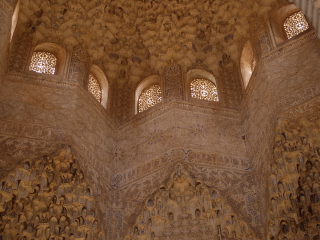

 Finely tuned geometric patterns dance across richly colored mosaic tile, fancifully interpreting mysteries such as the heavens and the oceans.
Finely tuned geometric patterns dance across richly colored mosaic tile, fancifully interpreting mysteries such as the heavens and the oceans.


 Coffered ceilings, pieced from honeyed wood richly highlighted with gold and paint, warm the heavens they represent.
Coffered ceilings, pieced from honeyed wood richly highlighted with gold and paint, warm the heavens they represent. Water burbles softly from serene marble fountains and flows gently in gazing pools lest the view be distorted. They are fonts of gentle sound, saving symphonic overtures for the sea just beyond the mountains to the south.
Water burbles softly from serene marble fountains and flows gently in gazing pools lest the view be distorted. They are fonts of gentle sound, saving symphonic overtures for the sea just beyond the mountains to the south.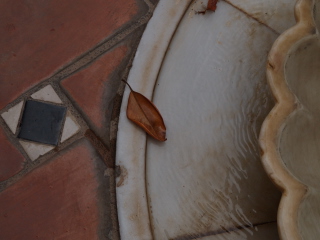
 Quintessential Mudéjar architecture, isolated from mainland Islamic influence, allowed to grow and literally flourish at the hands of hundreds of skilled artists and artisans.An earthly paradise.
Quintessential Mudéjar architecture, isolated from mainland Islamic influence, allowed to grow and literally flourish at the hands of hundreds of skilled artists and artisans.An earthly paradise.
Every building in Sevilla´s center is a museum, intact exteriors and extant subterrany, thousands of lifetimes. Constructions projects surely factor in archeological studies as part of the timeline. How much higher is street level in modern times--10 feet, 20 feet, or more?El Archivo General de Indias captured my imagination in an exhibit called El hila de memoria, The Threads of Memory: Three Centuries of Spanish Presence in the United States. From 1513 to 1822, Spain explored, established missions and forts, and supported the United States in its fight for independence. The exhibit says that this presence is unfamiliar to many Spaniards. It is my pentimento, tracings of a language and culture familiar on many levels of my life in Texas.People, places--Coronado, Álvarez de Pineda, Navarette, Dolores, San Antonio de Bejar, Los Adaes. . . Maps of the Texas coast, muster books for presidios listing pay owed to foot soldiers and commandantes, correspondence from George Washington.  Coastal map of the Gulf of Mexico, 1544
Coastal map of the Gulf of Mexico, 1544
Archivo General de Indias, Sevilla, España
Designated a UNESCO World Heritage site, the Archivo is a treasure trove of original documents detailing Spain´s history in the Americas. Fittingly, it is housed in a building that once served as a merchant´s exchange, the focal point for Spain´s commerce with its empire.I eye this thread of entwined history with Spain; it is not yet unraveled.
Penas tiene mi mare
penas tengo yo y las que siento
son las de mi mare que las mis no.
Heart wrenching strains of a cante jondo grip my heart and stop me mid-stride.Overhead the sound bubble showers the aching music over me, drawing me into Prohibido El Cante. Flamenco Y Fotografía, an exhibit at the Centro Andaluz de Arte Contemporáneo.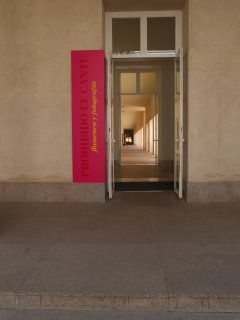

 Centro Andaluz de Arte Contemporáneo is a converted monastery, repurposed as a regional arts center. Its walls and spaces echo its cloistered past,
Centro Andaluz de Arte Contemporáneo is a converted monastery, repurposed as a regional arts center. Its walls and spaces echo its cloistered past,



 and oddly contain and soften the sounds and images of flamenco captured in the exhibit.Part of PhotoEspaña, a year-long celebration of photography, the 200 photographs of Prohibido El Cante span an intriguing aesthetic of dance, music, artistic vision and technique. Visually drawn to flamenco, artists such as Robert Capa, Man Ray, Henri Cartier-Bresson, Ortiz Echagüe, Isabel Muñoz, Paco Sánchez and 64 others sought to elicit the passion, the movement through gelatin silver, photogravure, carbon fresson and other photographic processes.
and oddly contain and soften the sounds and images of flamenco captured in the exhibit.Part of PhotoEspaña, a year-long celebration of photography, the 200 photographs of Prohibido El Cante span an intriguing aesthetic of dance, music, artistic vision and technique. Visually drawn to flamenco, artists such as Robert Capa, Man Ray, Henri Cartier-Bresson, Ortiz Echagüe, Isabel Muñoz, Paco Sánchez and 64 others sought to elicit the passion, the movement through gelatin silver, photogravure, carbon fresson and other photographic processes. MAN RAYDanzas horizontales, 1934copy of original in Georges Pompidou Center, Paris
MAN RAYDanzas horizontales, 1934copy of original in Georges Pompidou Center, Paris ARCHIVO SERRANOAcademía de baíle del Maestro Otero, Sevilla, ca. 1905Copy of original, Fototeca Municipal de SevillaIn the end, though, flamenco is about attitude.
ARCHIVO SERRANOAcademía de baíle del Maestro Otero, Sevilla, ca. 1905Copy of original, Fototeca Municipal de SevillaIn the end, though, flamenco is about attitude.
Sevilla´s hearth stones--sidewalks, streets, buildings--slowly regain their ancient heat. Pedestrians trace shadows of buildings with steps slowed by calendar pages. Tucked away in shaded corners, coolness lingers, poised to extend a delicate finger. A touch, a remnant of spring.
We board the train for Puerto de Santa María, in search of salt water, in search of the people who sailed miles of blue water only to come up short in expectation but long in exploration and, sadly, exploitation.Google maps can be wrong, as wrong as the many hand-drawn maps of the West Indies and the traced edges of two continents. We follow our map and walk a mile and another half before turning around to backtrack, to head in the right direction from the train station.At last, we recognize where we are, a seaside town, seagulls overhead, masts with their halyards clanging in the distance, and the faint odor of a port, seasoned with sailors, salt, tobacco, and here, sherry. Our hotel sits next to the quay where boats tied up to take on water, cargos, crew. Down the street, water, no longer potable, still pours from spigots where ships, including those of the Colón family filled their casks for trans-Atlantic voyages.Smaller than Sevilla, Puerto de Santa María sits across the Bahía de Cadíz from Cadíz proper. It looks out to the Atlantic, still west of Gilbraltar, of the Pillars of Hercules guarding the Mediterranean. There are the expected sidewalk cafés, narrow cobbled streets, confetti and rosemary remains of Corpus Christi processions, and a small, brown beach.

 There is a community cultural center displaying the work of a local artist, paintings of the waterfront and of his apartment. In the foyer, a model of La Niña draws us to its case and to the map of the new world, made shortly after the turn of the 14th century. It is flowered with compass roses that orient the many lines radiating from their centers, headings that led mariners across the Atlantic and beyond.
There is a community cultural center displaying the work of a local artist, paintings of the waterfront and of his apartment. In the foyer, a model of La Niña draws us to its case and to the map of the new world, made shortly after the turn of the 14th century. It is flowered with compass roses that orient the many lines radiating from their centers, headings that led mariners across the Atlantic and beyond. 
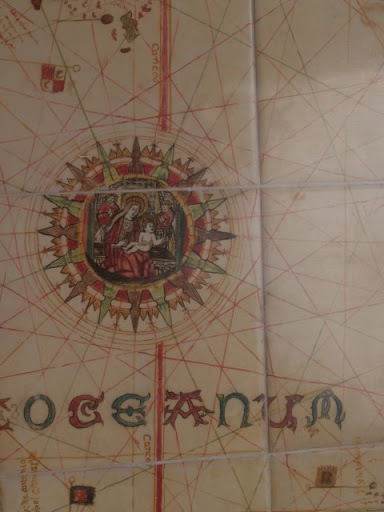 Drawn by Juan de la Cosa in 1500, pilot for the Colón voyages and owner of the Santa María, it is the first map to show the coastline of the Americas. We find his memorial, tucked away behind the Castillo de San Marcos, built by Alfonso X as a church castle. A Cristina Carreño bust of de la Cosa shouts defiance and arrogance. What can be said about a man who redrew history!
Drawn by Juan de la Cosa in 1500, pilot for the Colón voyages and owner of the Santa María, it is the first map to show the coastline of the Americas. We find his memorial, tucked away behind the Castillo de San Marcos, built by Alfonso X as a church castle. A Cristina Carreño bust of de la Cosa shouts defiance and arrogance. What can be said about a man who redrew history!

 There is a central meat and fish market, new, clean, filled with meat, meat and more seafood than we can begin to identify. I ask to photograph a case brimming with fish, shellfish and crustaceans of every imaginable and unimaginable shape and size. The fishmonger holds up a giant lobster, its eyes visibly twirling as it tries to make sense of where it is.
There is a central meat and fish market, new, clean, filled with meat, meat and more seafood than we can begin to identify. I ask to photograph a case brimming with fish, shellfish and crustaceans of every imaginable and unimaginable shape and size. The fishmonger holds up a giant lobster, its eyes visibly twirling as it tries to make sense of where it is.

 There are also sherry bodegas, strategically built close to the wharves to disburse this liquid gold around the world. Sherry is a fortified wine, produced only in the triangle of soil, sea air and sun of southern Andalucía and capable of withstanding long ocean voyages. We sign up for a tour and tasting.A few steps beyond our hotel, we enter the dark cloistered world of the sherry bodega, literally. Sherry bodegas are built like churches with steeply pitched roofs to siphon off hot summer temperatures. Natural climate control. Inside, American oak barrels, stacked in an offset pattern three high, exude the sweetish, vinegary smell of yeast at work and form the basis of the solera system used to maintain consistency. Fino, manzanilla, amantillado, olorosa, each variety is a far cry from the familiar cream sherry so popular in Great Britain.
There are also sherry bodegas, strategically built close to the wharves to disburse this liquid gold around the world. Sherry is a fortified wine, produced only in the triangle of soil, sea air and sun of southern Andalucía and capable of withstanding long ocean voyages. We sign up for a tour and tasting.A few steps beyond our hotel, we enter the dark cloistered world of the sherry bodega, literally. Sherry bodegas are built like churches with steeply pitched roofs to siphon off hot summer temperatures. Natural climate control. Inside, American oak barrels, stacked in an offset pattern three high, exude the sweetish, vinegary smell of yeast at work and form the basis of the solera system used to maintain consistency. Fino, manzanilla, amantillado, olorosa, each variety is a far cry from the familiar cream sherry so popular in Great Britain. On our way to the tasting room, we pass barrels signed in white chalk by chefs, a marketing strategy to encourage the current resurgence of interest in sherry. Signatured blends by signature chefs. ¨Josep Roca" is florished across a barrel, beneath his handwritten sentiment,"¡Botas llenan de lagrimas!"
On our way to the tasting room, we pass barrels signed in white chalk by chefs, a marketing strategy to encourage the current resurgence of interest in sherry. Signatured blends by signature chefs. ¨Josep Roca" is florished across a barrel, beneath his handwritten sentiment,"¡Botas llenan de lagrimas!" Fortified by four varieties of sherry, we board the ferry for Cádiz. Hopes run high for sailboat sightings. At last, a triangle of white appears. This trip we are green with envy, only, not seasickness. One of us is haunted by ferries, of a Great Lakes trip that ends in an unplanned shore run back to the parked car, avoiding a repeat of the outward ferry ride. The bay is calm today. The sea air cools us in the heat but generates its on heat of longing to be under sail.Cádiz is hot, and we zigzag along shaded sides of the streets to the beach. We have not come with swimsuits, only sandals, so we plunge only our toes in the Atlantic surf. Our return trip tickets send us back to the ferry terminal, and we are rewarded with the sight of 50-foot yacht motorsailing in the bay.Sunday morning, we breakfast and check our bags before one last Puerta de Santa María excursion. We board a bus, hoping that it takes us within walking distance of a marina across the bay. To change buses, we step off and are told that the bus we want leaves from the bus stop on the opposite side of the traffic circle. We thank the gentleman who has advised us.It is Sunday. The bus schedule is abbreviated. We sit at the stop, heat building up under its plastic canopy. We are objects of curiosity in this area less frequented by tourists. And yet, we are greeted. One such greeting comes from a twinkley-eyed gentleman, who escorts an older woman. Our return greeting immediately stamps us immediately as tourists. He smiles, and exchanges a few pleasantries with us before indicating that he must continue, for the sake of his companion.
Fortified by four varieties of sherry, we board the ferry for Cádiz. Hopes run high for sailboat sightings. At last, a triangle of white appears. This trip we are green with envy, only, not seasickness. One of us is haunted by ferries, of a Great Lakes trip that ends in an unplanned shore run back to the parked car, avoiding a repeat of the outward ferry ride. The bay is calm today. The sea air cools us in the heat but generates its on heat of longing to be under sail.Cádiz is hot, and we zigzag along shaded sides of the streets to the beach. We have not come with swimsuits, only sandals, so we plunge only our toes in the Atlantic surf. Our return trip tickets send us back to the ferry terminal, and we are rewarded with the sight of 50-foot yacht motorsailing in the bay.Sunday morning, we breakfast and check our bags before one last Puerta de Santa María excursion. We board a bus, hoping that it takes us within walking distance of a marina across the bay. To change buses, we step off and are told that the bus we want leaves from the bus stop on the opposite side of the traffic circle. We thank the gentleman who has advised us.It is Sunday. The bus schedule is abbreviated. We sit at the stop, heat building up under its plastic canopy. We are objects of curiosity in this area less frequented by tourists. And yet, we are greeted. One such greeting comes from a twinkley-eyed gentleman, who escorts an older woman. Our return greeting immediately stamps us immediately as tourists. He smiles, and exchanges a few pleasantries with us before indicating that he must continue, for the sake of his companion.
Still no bus. We give up. As we walk toward the hotel, we encounter again, the courtly gentleman and his companion. He delightedly engages us in conversation and introduces us to his companion, his mother-in-law, su suegra. Proudly, he states his good fortune in having such a handsome, young-looking mother-in-law. Because of her, he knows that his wife will be as young and handsome as she grows older. She blushes.
We collect our bags and head to the train station, sitting outside on the platform. We catch the hot afternoon wind and wonder about maps--those generated from billions of bits of electronic data and those generated from sightings, landfalls and legends, from the decks of small wooden ships.

























